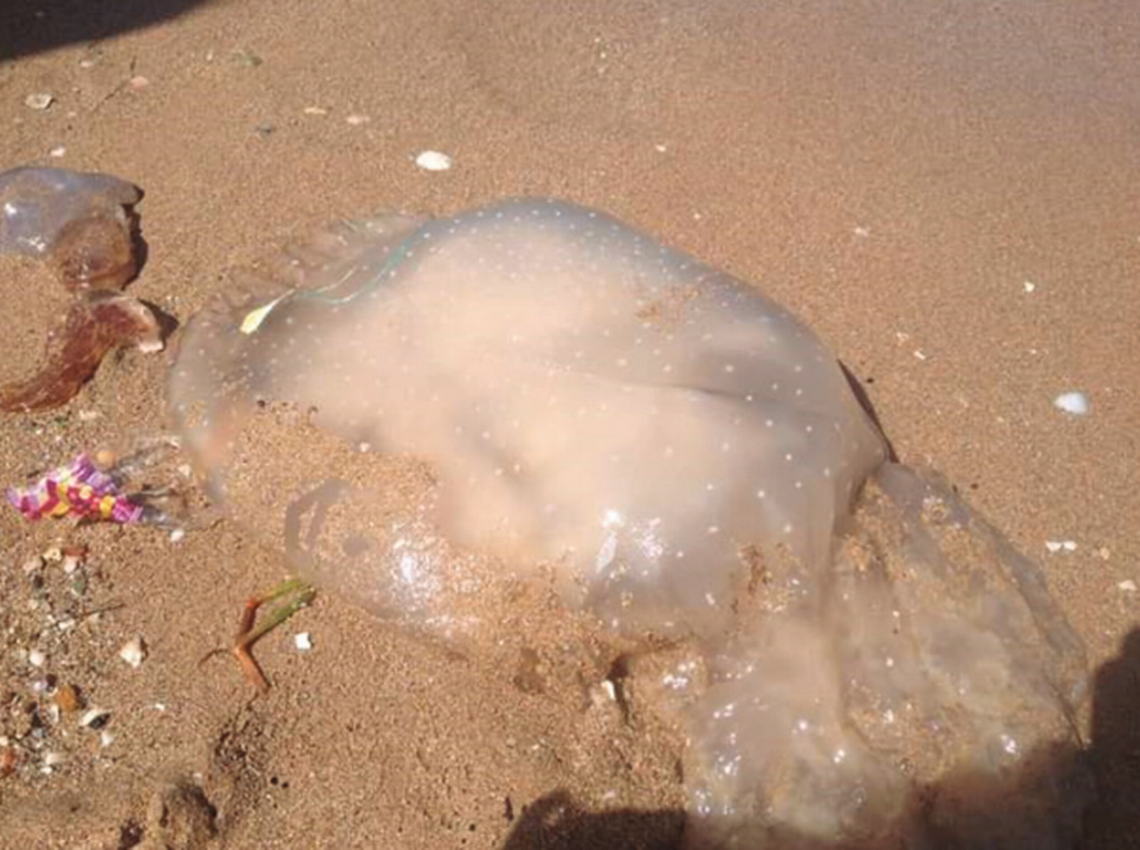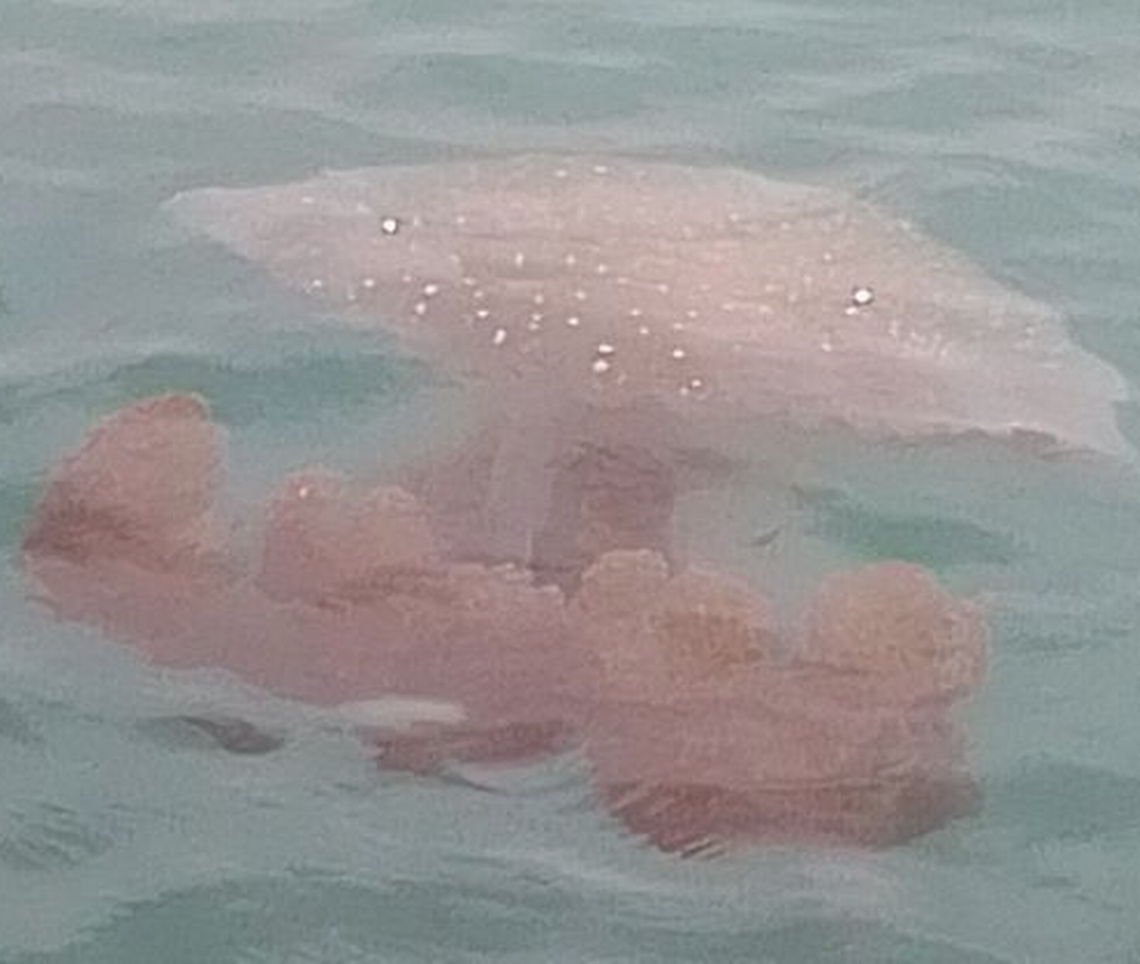Divers spot weird, blobby creature for first time off Morocco. See the ‘alien species’
Off the northern coast of Morocco on the Mediterranean Sea, a group of scuba divers hit the water.
As they scoured the clear water above a sandy seafloor, they noticed something floating in the waves.
Bell-shaped and translucent, it was a large jellyfish covered with small, white polka-dots. The scuba divers took a photo of the jellyfish and continued their dive.
Also in 2017, the jellyfish washed up on the beach, a large gelatinous blob of a body with cloudy, white tentacles.
When experts took a look at the beached sea creature, its shape and color made an identification obvious, but it raised more questions than answers, according to a study published in the journal Mediterranean Marine Science on April 30.
There on the beach was an Australian spotted jellyfish — an “alien.”

This marked the first time phyllorhiza punctata, or the Australian spotted jellyfish, has been seen off the shores of Morocco, according to the study, despite sightings in neighboring Tunisia.
The species is native to the oceans of the Indo-Pacific, the researchers said, and as far south as Australasia.
So far away from home, the spotted jellyfish is considered an “alien species,” meaning it is living in an area where it is not native, but researchers are still working to determine how established the species is in the area, according to the study.
Species can be introduced in areas where they don’t live naturally by being released by a fisherman or hunter, escaping from a farm or zoo, accidentally being transported on another animal like parasites, hitchhiking on some form of transportation like a boat or car, working their way through natural corridors like connected waterways or what researchers call “unaided” when the spread can’t be identified, the researchers explained.
The study analyzed as many as 46 “alien” species that were living off the coast of Morocco, and tried to identify how they got there.
The researchers believe the spotted jellyfish was a stowaway.

“In the Mediterranean, the most common pathway is Transport-Stowaway, with 23 alien species having been likely introduced through two vectors, hull fouling or ballast water,” according to the study.
Hull fouling is when a large amount of marine life builds up along the hull of a ship, like barnacles, and catches other marine creatures to take them along for the ride, introducing animals to oceans they aren’t native to, according to the European Boating Association.
Ballast water is water that is held in the bottom of cargo ships that are used to help the stability and the maneuverability of the ship, according to the U.S. Department of Agriculture. Water is pumped into the ship at port and then can be dumped out again when it reaches its final destination, moving creatures that were sucked up into the boat from one place to another.
It is likely one of these practices that brought the Pacific Ocean creature to the Mediterranean, possibly through the massively active Suez Canal, according to the study.
The jellyfish has shown up in mysterious places before, much to the concern of biologists.
In June 2023, an Australian spotted jellyfish washed up on the shores of Padre Island in Texas.
“Traveling in large groups, the Australian Spotted Jellyfish can be big, up to 20 inches across! But don’t worry, they have a mild venom, and are not considered a hazard to people. In fact, their venom is so weak they can’t use it to stun prey. Instead, they are filter feeders and eat tiny microorganisms called zooplankton,” the Padre Island National Seashore wrote in a June 30 Facebook post. “Unfortunately, these jellies are invasive in the Gulf of Mexico and in great numbers can consume large quantities of zooplankton, making it hard for local marine wildlife to find food.”
Park officials said the jellyfish can deplete resources in the water for the local species, and they are a “not-so-welcome visitor” in Texas, according to the post.
The researchers in Morocco share the concern.
“Despite the relatively low number of alien species in the Moroccan Mediterranean, a considerable proportion of them (31%) are species that have been classified as invasive in some part of their introduced range, having significant impact on native biodiversity and ecosystem functioning,” the researchers said.
More research is needed to determine what the impacts of the Australian spotted jellyfish may be — and if they are here to stay.
The species was spotted in Nador, on the coast of the Alboran Sea in the western pocket of the Mediterranean Sea.
50-foot sea creature washes up on Delaware shore. But rescue proves too ‘treacherous’
Songs heard in Antarctic waters suggest endangered creatures are thriving, study says
Amateur angler lands 143-pound monster catfish in UK — and may set national record
Glowing sea creature with 15 tentacles found off Florida coast. It’s a new species
